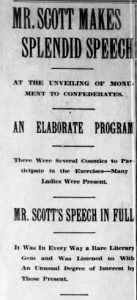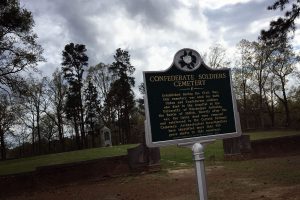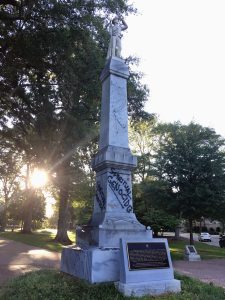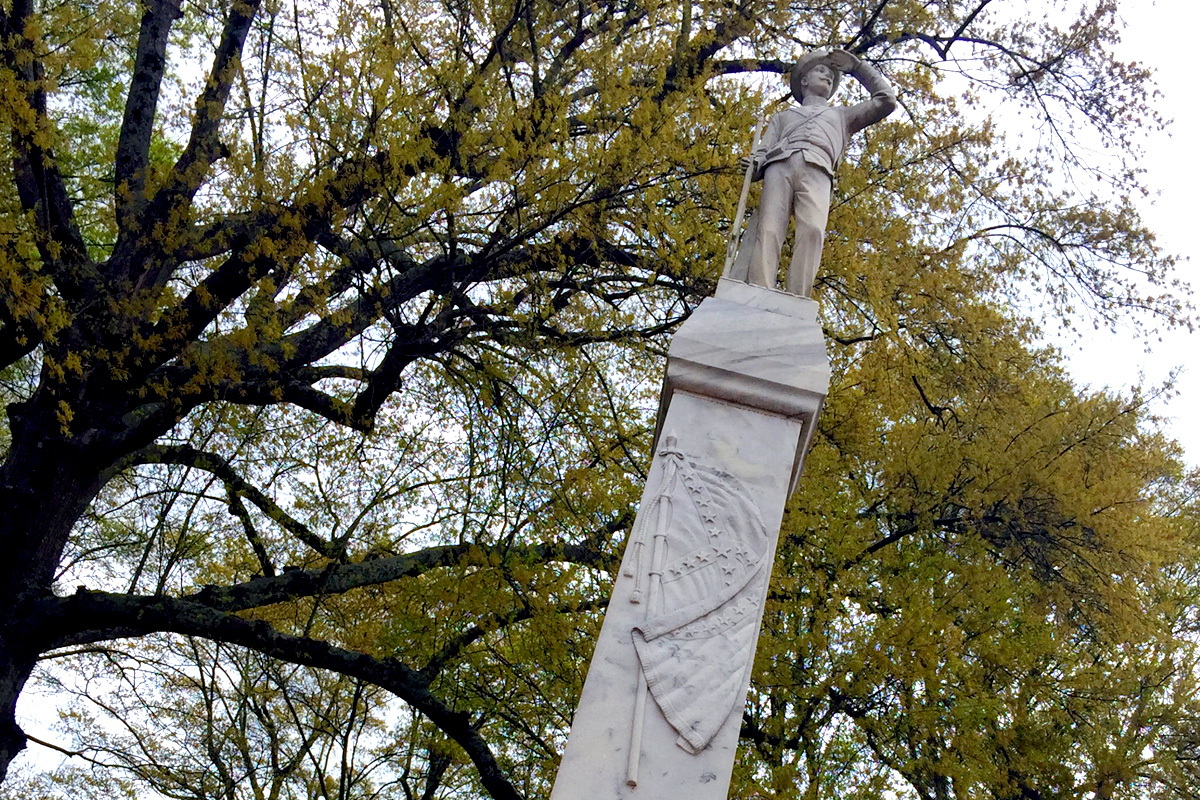OXFORD, Miss.—The late University of Mississippi history professor John Neff had looked for years before his death in January. Last Friday, his colleague, Dr. Anne Twitty, found the treasure they had long chased while clicking around newspapers.com. She could finally read the dedication speech for the Confederate monument at Lyceum Circle on the University of Mississippi campus.
The Vicksburg Herald printed gubernatorial candidate Charles Scott’s remarks in full on May 11, 1906, with the page-one headline, “Mr. Scott Makes Splendid Speech,” then calling it a “Rare Literary Gem.”
Scott heralded the Confederate veterans from several counties who attended the statue’s dedication. He praised them for fighting reforms to help newly freed slaves during the Reconstruction era after the Civil War ended.

“There was a time, I grant you, during the nightmare called Reconstruction, when these men boldly, aggressively and intentionally overrode the letter of the law that they might maintain the spirit of the law and preserve Anglo-Saxon civilization as a priceless heritage for their children’s children and for the benefit of our common country, the people of the north as well as the people of the south,” Scott proclaimed on May 10, 1906, about the veterans who had worked after the war to spread Jim Crow, as the 30-foot-tall statue of a saluting rebel soldier provided a backdrop.
Scott called the “Southern Confederacy” the “youngest, the noblest and the bravest” of all nations on earth, adding that it left a “lasting impression of grandeur and glory on the hearts and minds of the universe, that can never be effaced.” Scott told the veterans he had heard “Dixie” play in the Grand Hotel of Paris where he and others let out the battle cry known as the Rebel Yell, believed to have terrified U.S. troops as Confederates advanced on them in battle.
A Mississippi Delta planter who served the Confederacy during the Civil War, Scott was paroled in Gainesville, Ala., after the U.S. won the war. He later returned to Mississippi to study law, and then built a practice in Bolivar County back in the Delta. In the speech, Scott decried that northerners had ignored the U.S. Supreme Court’s 1857 Dred Scott decision, which denied citizenship to black Americans, during the north’s Reconstruction efforts.
“The rights of southern property owners were trampled underfoot,” Scott boomed in front of the UM statue. “Southern soil was invaded.” Every Confederate soldier, he said, “whether officer or private,” was united in purpose: “These men battled for a principle in which each believed with all his heart and soul and mind.”
Despite being an active member of the then-pro-slavery Democratic Party, Scott had not previously held political office when he started campaigning for the governor’s seat in his old Confederate uniform. His words provide a window into the social atmosphere of Oxford during the Jim Crow era—and the original beliefs about the statue that has overlooked the UM campus for over a century.
Dr. Twitty called Scott’s verbose speech mostly “boilerplate lost cause rhetoric” on June 14 and in an Atlantic essay out today. Scott himself referred to the “spotless banner of the Lost Cause” in the speech.
“Scott repeatedly defends the right of secession, argues that slavery was a ‘mere incident’ to the Confederate cause, and exalts the gallantry of Confederate soldiers and the nobility of white southern women,” Twitty tweeted.
But it was Scott’s promise to preserve “Anglo-Saxon civilization”—straight-up white supremacy—that really caught the slavery historian’s eye. Scott further predicted that “our brethren of the north will see this grave question as we see it,” referring of course to white brethren. “[T]hereafter,” he believed, “for this one act alone the memory of the Confederate soldier will be reverenced by the north as it is already loved and revered by all the people of the south.”
Scott’s prediction may be crumbling 114 years after he dedicated the memorial. The Mississippi Institutions for Higher Learning voted Thursday morning to move, after years of controversy and efforts by UM students and others with much less reverence for the Confederacy than Charles Scott and the women who erected the statue to celebrate the “lost cause” of white supremacy.
‘Lasting Gratitude of the Civilized World’
On Twitter, Dr. Anne Twitty acknowledged the irony of Charles Scott’s beliefs about Confederate soldiers themselves. The men he refers and speaks to in his speech are Civil War veterans who operated during Reconstruction in a collective effort to further subjugate African Americans, either through writ law or violence—and to preserve white supremacy and Anglo-Saxonism, which was then shorthand for being superior to darker races.
Historian Kenneth S. Greenberg defined Anglo-Saxonism, popular across the U.S. in 1906, as “the belief that Anglo-Saxons were a superior race destined to rule over other races or to insure their extinction.”

The actions of Confederate sympathizers during Reconstruction do overshadow the efforts of Confederate military forces, Twitty said, but not in the honorable way Scott intended to promote. Instead of propping up the supposed heroism of rebel forces, the actions of Mississippians during Reconstruction offer a glimpse into the narrow and harmful views that have been perpetuated for over 150 years in the state, even as many defenders of such memorials say they are there to honor the bravery of the soldiers.
Scott asserted that former Confederate resistance to Reconstruction entitled veterans to the “lasting gratitude of the civilized world,” which, he suggested, was increasingly beginning to see the “race question” in the same way white southerners did.
In the speech, Scott said Confederate veterans did what they had to do to take back the South during Reconstruction. “[H]e saved the south from impending financial ruin and soon restored something of her former prestige and prosperity,” he claimed. Indeed, Reconstruction ended in 1877, with many of the rights the U.S. had conferred to former slaves undone in the wake of Ku Klux Klan violence, Black Codes, Jim Crow laws and other efforts by white southerners to subjugate black Americans.
Scott praised the women of the Albert Sidney Johnston Chapter 379 of The United Daughters of The Confederacy who erected the monument that leers over the historic area that enslaved African Americans built during the inception of the university. Many sons of planters enrolled in UM when it opened in 1848. As the Civil War got under way, most current UM students enlisted to fight for the Confederacy, with many dying in battle. Supposedly, student soldiers stacked their books on the site of the current statue when they left to fight for the cause that Mississippi leaders made clear in its Declaration of Secession was “thoroughly identified with the institution of slavery—the greatest material interest of the world.”
UM’s Confederate soldier statue is inscribed with several lines of Lord Byron’s poem, “The Siege of Corinth,” written in 1816 to memorialize the Ottoman massacre of the Venetian garrison holding the Acrocorinth in 1715. The inscription reads as follows:
“They fell devoted, but undying;
The very gale their names seem’d sighing:
The waters murmur’d of their name;
The woods were peopled with their fame;
The silent pillar, lone and grey,
Claim’d kindred with their sacred clay;
Their spirits wrapp’d the dusky mountain,
Their memory sparkled o’er the fountain;
The meanest rill, the mightiest river
Roll’d mingling with their fame for ever.”
A simpler inscription on the statue lauds local honor: “To the heroes of Lafayette county whose valor and devotion made glorious many a battlefield.”
Twitty says UM’s statue and similar monuments, many of them erected in a wave by chapters of the Daughters of the Confederacy, historically reflect the violent, racist times when they went up.

“Because they’re not put up during the Civil War or even in the decades immediately following the Civil War, they tell us so much more about what was going on at the turn of the century when they were put up,” Twitty said in an interview. “What was going on at the turn of the century in Mississippi, and in Lafayette county was the imposition of Jim Crow, the ascendency of white violence against black people.”
It was also a time when whites were becoming the majority in Mississippi and flexing their desire for full superiority. “Mississippi was a majority-black state in the 1860s when the Civil War happened. It was a majority-black state in the 1890s when a new state constitution and the new state flag was adopted,” Twitty explained. “It’s really only in the very beginning decades of the 20th century that so many black people flee to the north in the Great Migration that you get a majority-white Mississippi.
“So, the idea that that monument reflects even the majority of Mississippians in Mississippi at the time is laughable.”
‘Creating a Mini-Arlington for Confederate Soldiers’
Amid protests of systemic racism, monuments with ties to oppression and slavery are now being taken down all over the nation. Protesters have torn some of them down—even dumping a bust of slave owner John McDonogh unceremoniously into the Mississippi River in New Orleans—while state and local governments are deciding to remove or preserve others.
Following protests in Mississippi and demands to remove the statues—and even the spraypaint desecration of Scott’s adored UM monument by a Jewish graduate calling it “spiritual genocide”—the IHL quickly agreed to jumpstart stalled discussions about the potential relocation of the Confederate statue to the rather barren Confederate cemetery on the edge of campus behind the “Tad Pad,” the nickname of the Tad Smith Coliseum. Such a cross-campus relocation follows the incrementalism UM has followed over the decades as it has gradually let go of official uses of the Confederate flag, mascot Colonel Reb and other symbols, but not all at once.

“Who’s gonna tell the (U)niversity of Mississippi that decentering white supremacy doesn’t mean moving white supremacy to somewhere else on campus,” Cam Calisch, a UM master’s student in southern studies, tweeted Thursday after the UM vote.
The cemetery originated during the Civil War when University of Mississippi facilities were used as a hospital to treat both Union and Confederate soldiers. Union soldiers buried in the cemetery have since been interred elsewhere, leaving only an undetermined number of Confederate remains. The graves are not marked.
When speaking with the Mississippi Free Press before Thursday’s IHL vote, Dr. Twitty shared concerns about relocating the Confederate statue to the cemetery. First, the relocation site presents a historical and ethical dilemma. “We now no longer know who exactly is buried there still,” she explained. “We don’ t even really know where in the plot there are remains.”
Yet, she said, a member of the Chancellor’s Advisory Committee on History and Context and wealthy alumni had decided to put up headstones marking the graves of Confederate dead. “So,” she said, “my question is, are there any plans to proceed with placing headstones? And if so, as a historian, I have extraordinary issues with this move.”
Dr. Jack Carey, a University of Mississippi alumnus and current professor of American Studies at the University of Alabama, told the Mississippi Free Press that he is also concerned about using the cemetery as the statue’s next home.
“One of the concerns would be that you end up creating this thing that becomes a magnet-like the university so often is—for people who want to cling to this stuff,” Carey said of Confederate fans and hobbyists. “Does it become something that becomes attractive to people from even outside of the university community who want to sort of rally around these symbols for as long as they can?”
This morning, as IHL was meeting over the question, Twitty tweeted a quote from its explainer of the problem plan: “Within the walls of the cemetery, new headstones will be added to offer remembrance for the souls buried on the grounds along with a stone path to the existing marker in the cemetery.” Police would also monitor the cemetery through security cameras, IHL added.
Back in 2017, Twitty tweeted, a similar recommendation surfaced under Chancellor David Vitter, but it didn’t get off the ground: “These efforts went nowhere fast for a variety of reasons, perhaps most especially because 1) there were fears that creating a mini-Arlington for Confederate soldiers would continue to draw neo-Confederates to campus and introduce yet another shrine to the Lost Cause….”
Carey shares Twitty’s second major area of concern. Removing Confederate monuments requires an enormous amount of money. Professor Carey noted that state universities, who are facing financial rigors in the midst of Covid-19, will have to decide whether or not it is reasonable to spend large portions of money on housing and relocating these statues.

Twitty said cost estimates for relocation of the statue had been rumored to be somewhere between $400,000 and $650,000.
But Thursday morning, the IHL board of trustees approved UM’s proposal and $1,150,000 to make it happen, as well as sprucing up the cemetery, saying it will rely on private funds. “The Confederate Monument will be accessible by a newly-laid brick path surrounded by trees and enhanced with lighting. Included in these plans will be a new marker to recognize the men from Lafayette County who served in the Union Army as part of the United States Colored Troops during the Civil War,” an IHL proposal stated.
Twitty is skeptical, citing the historic pattern of the university failing to follow through with recommendations from student and faculty organizations. Although UM claims to have taken steps to reconcile with the past, including placing plaques in front of the three remaining campus buildings constructed by slaves—the Old Chapel, Barnard Observatory, and the Lyceum—Twitty says they have balked on other efforts.
For example, the Chancellor’s Advisory Committee on History and Context, or CACHC, is a now-defunct committee that worked toward promoting a more inclusive campus. It attempted to have Vardaman Hall renamed in 2016 due to the extreme and overt racial violence its namesake, Mississippi Gov. James K. Vardaman, promoted. As of today, it’s still Vardaman Hall.
Twitty is concerned that the fate of the statue’s removal may quietly go the way of Vardaman Hall.
‘Confronting White Supremacy and Racism in the Face’
The relocation of the Confederate monument is the long-awaited move that many student leaders have wanted. Arielle Hudson, the Tunica native who is the University of Mississippi’s first black woman Rhodes Scholar, helped lead student efforts to have the Confederate statue relocated to the cemetery on campus. Hudson acknowledged the work that lies ahead to the Mississippi Free Press after the Thursday IHL vote.

“This is not the end. Not even really the beginning. We still have a long way to go, and this process is far from over,” Hudson, who is on the Mississippi Free Press advisory board, said.
Resolution co-author Leah Davis, a Tupelo native, praised students’ tenacity for the decision to relocate the Confederate monument. “The relocation itself is a victory,” she said. “I think it’s a wonderful testament to the power of student voice, to the power of student activism, and student leadership.”
The tall Confederate monument nearby on the popular Oxford Square is likewise drawing a newly energized public criticism. “I do plan to get more involved with that effort, too,” Hudson said Thursday. “I know they need a little help with that, that whole push, but it needs to go. I think all of it should be removed. It is also in a high-traffic volume area in a place that is supposed to be welcoming to all people.”
Davis said she has been recently working to engage and educate Oxford community members to push for the square monument to be relocated. “I think it’s important that we start confronting white supremacy and racism in the face, and I think that we can start by doing the bare minimum, which is moving these statues,” Davis said.
Local leaders including Oxford Mayor Robyn Tannehill have voiced support for the statue’s relocation, but the Lafayette County Board of Supervisors control it, and Mississippi state law prohibits relocation of war monuments.
The Lafayette County Board of Supervisors is meeting Monday, June 22, at 5 p.m. in the Chancery Court building where citizens can voice their concerns about the Confederate monument. Hottytoddy.com reported that Board President Mike Roberts said there will be no votes during this meeting. The public hearing comes after a crowd of more than 100 citizens conducted a silent protest at the Chancery Court building early Monday, June 15.

In her closing thoughts to the Mississippi Free Press, Twitty touched on the social complexities of the Magnolia State, which was once the richest from slavery and where 49% of families owned slaves in 1860. “This is a state that has elected Tate Reeves governor, but it’s also a state that produced Fannie Lou Hamer, and that is the reality of Mississippi,” she said.
“If you live here and you are committed to making it better, you need to recognize that it’s a marathon and not a sprint.”
That marathon, and efforts now to face the real history behind the Confederacy and its monuments, fly in the face of Charles Scott’s dream for a world fully united behind the goals of the Confederacy. In 1906, his words rested on the laurels of the South winning Reconstruction, if not the Civil War. He closed by sanctifying the “noble and patriotic purpose” of the Confederate daughters who erected the statue.
“It will serve, then, a double purpose by proclaiming to all future generations the gallantry of the Southern soldier and the nobility of the Southern woman,” Scott promised. “The one is a complement of the other, and together, they constitute the crowning glory of the Southern character. Such must be the thought of those who look upon its monumental shaft in the years to come.”
They’ll now just have to worship the monumental shaft over behind the Tad Pad.
Donna Ladd contributed to this story.
Read the MFP’s investigations of the plan to relocate the Confederate statue and enhance the UM cemetery and coverage across the state as efforts to move Confederate statues and memorials grow. See an infographic of Confederate memorials in Mississippi and report missing ones to data@mississippifreepress.com.






